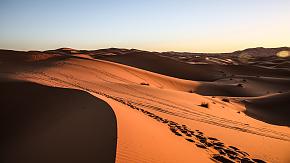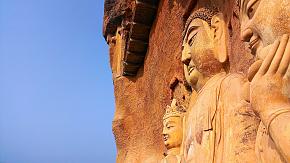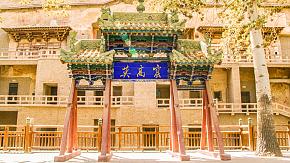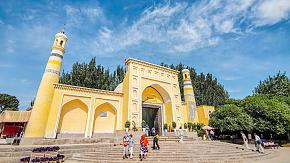About This Trip
Visit the highlights of Zhangye and Dunhuang on this 6-day tour. You will firstly explore Zhangye to admire the stunning Danxia landscapes and take a scenic drive from Zhangye to tour the ancient Mati Temple Grottoes. Then, head for Dunhuang by bullet train. In Dunhuang, you will see beautiful wall paintings in the famous Mogao Grottoes, relax in the desert wonder Crescent Moon Spring, and discover a grand scale of Yardang landforms Yardang Geopark.
Itinerary Summary
| DAY | PLACE | HIGHLIGHTS |
| 1 | Zhangye | Arrival |
| 2 | Zhangye | Danxia Landscape, Mati Temple Grottoes |
| 3 | Zhangye, Dunhuang | Giant Buddha Temple in Zhangye, Bullet Train to Dunhuang |
| 4 | Dunhuang | Mogao Caves, Western Thousand Buddha Caves, Crescent Moon Spring, Singing Sand Dune |
| 5 | Dunhuang | Yardang National Geopark |
| 6 | Dunhuang | Departure |
Itinerary
-
Day 1: Arrive in Zhangye
Having been an important town on the ancient Silk Road, Zhangye is now famous for not only the splendid culture but also the colorful Danxi landscape.
It is easy to arrive in Zhangye from Xi'an or Lanzhou by high-speed train or flight. On arrival, your hospitable guide and driver will pick you up, transfer you to your hotel, and help you check in.
- Zhangye
-
Day 2: Zhangye, Danxia Landscape & Mati Temple Grottoes
Danxia, a unique landscape formed from colored sandstone and minerals with millions of years of natural erosion, can be aptly translated to Rosy Cloud. As the name reveals, the mountains here seem like colorful rippling waves with vibrant red, orange, yellow, and blue. These colors usually intensify during different times of the day.
Today, after marveling at the Danxia landscape at Zhangye National Geopark we will visit Mati Temple (about 70 kilometers to Zhangye) to discover its time-honored Buddha statues and temples caved in the cliff. On a clear day, you can also get a majestic vista of the Qilian Mountain while exploring these temples and caves.
- B L
- Zhangye
-
Day 3: Zhangye - Dunhuang, Giant Buddha Temple
Today, before taking the bullet train to Dunhuang, you will visit the Giant Buddha Temple, the only temple built in Western Xia, a Tangut-ruled empire in northwestern China between 1038 and 1227. The temple today is a Buddhist art museum that integrates architecture, murals, sculptures, calligraphy, and historical relics with great significance for studying the cultural exchanges between China and the Western Regions.
Arrive in Dunhuang after about five hours, be picked up and transferred to your hotel for the night.
- B
- Dunhuang
-
Day 4: Dunhuang, Mogao Grottos & Crescent Moon Spring
As a transportation hub and trade center lying on the junction where the two major routes within the Silk Road network meet together, Dunhuang was also a paradise where Eastern and Western civilizations collided and blended. Along with colorful commodities brought by merchants also came different religions, languages, arts, and production techniques. Today, from the colorful murals in the most famous Mogao Caves and the Western Thousand Buddha Caves, we can glimpse the prosperity of that distant era, about the religions, political, diplomatic, singing and dancing, farming, hunting, business, travel, and daily life.
Late in the afternoon, enjoy some relaxing time at the Crescent Moon Spring and the Singing Sand Dune before returning to your hotel.
- B L
- Dunhuang
-
Day 5: Dunhuang, Yardang National Geological Park
The Yardang National Geological Park, about 180 km from the city of Dunhuang, is a magnet for nature lovers, especially those interested in geological formations. However, for the traders who traveled along the ancient Silk Road, Yardang Geopark with harsh natural conditions was one of the most sinister parts of their journey. Traveling from Dunhuang to this huge geopark, you will discover the true face of the so-called Devil's City and some historical relics, including the Yu Men Pass, the Great Wall of the Han Dynasty, and the He Cang Fortress.
- B L
- Dunhuang
-
Day 6: Dunhuang - Departure
Time to say goodbye to Dunhuang, where you can continue to Turpan and explore more about the Silk Road in Xinjiang or proceed to Xi'an and open a new chapter of your China tour. At the appointed time, the guide and driver will pick you up and transfer you to the airport or railway station for the departure to your next destination.
- B
Quick Question
Gallery
-
Zhangye National Geopark

-
Mati Temple Grottos, Zhangye

-
Mogao Caves, Dunhuang

-
Crescent Moon Spring, Dunhuang

-
Singing Sand Dune, Dunhuang

-
Yardang National Geopark

What Our Clients Say
"Great Customized Service", "Trip of A Lifetime", "Exceed All Expectations"
How It Works
-
Tell us your tour ideas Complete our inquiry form
-
Discuss with a travel specialist Customize your itinerary
-
Securely book your tour Confirm when you're satisfied


















